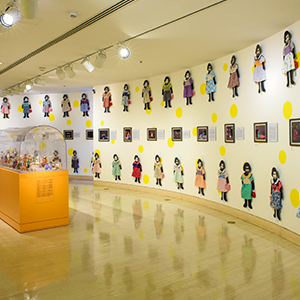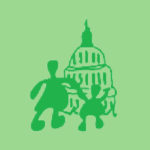One Example of How Art Aims to Deepen Understanding of Parenting
Faceless people are depicted carrying things, fleeing the scene, being
arrested by the police and scaling a large wall. One person wearing bright
colors in a Mexican design is facing the wall. Small, subtle crosses align
the bottom, likely signifying that people have died. At the top is a
horizon with a fading sunset. The American flag appears to be waving in the
sunset. Seeing this image may cause some parents and children to feel
unsettled. The image might be a reminder of the constant news headlines of
things the presidency may or may not be doing. Maybe. Or maybe there is a
different meaning altogether.
That is a simplified description of “El Otro Lado” (The Other Side), a
mixed media piece produced by Mexican artist, Francisco Loza. This
pressed-yarn-on-wood (“arte en estambre”) art is one of thirty-six works of
art presented by the American Visionary Art Museum (AVAM) in Baltimore,
Maryland as part of its major exhibition, “Parenting: An Art Without A
Manual.” (“Parenting”)
This Washington Parent magazine story purposely chooses to limit
the description and suggested interpretations of this art in order to
respect the purpose of the “Parenting” exhibit. As per the museum’s press
release, “The hope of this exhibition is to deepen collective understanding
of the challenges and importance of parenting …” It is difficult to
allow people to gain an understanding of the subject of parenting by
presenting art with pointed emotions and opinions that are the product of
one person’s point of view. Formulating a personal analysis of the art
balanced against one’s own life experiences is the preferred way of
interpreting and understanding “Parenting”.
Parenting Exhibition Offers Visuals and Information
Between October 6, 2018 and September 1, 2019, AVAM is hosting this complex
and intriguing art exhibition focusing on parenting, and is labeling it as
“humanity’s most essential performance art.” Though not everyone chooses to
parent a child, all of us had parents or some association with parental
figures in our lives at some point. The exhibition juxtaposes
multidimensional art pieces with “instructional wall text” containing
research, facts and figures to provide viewers ample opportunity to read,
digest and reach their own conclusions on parenting.
“Parenting” touches upon a broad array of parenting mini-topics, including
what it means to have parents and not have parents, “orphans,” the
biological effects on parental behaviors towards children during the “0 to
5” stage, experiences in losing parents, parenting children with
disabilities, the increase of grandparents thrust into becoming surrogate
parents and secrets and forgiveness within the family structure, to name a
few.
AVAM selected its 36 artists to be a part of the “Parenting” exhibit based
on a number of factors, but in staying true to its mission, called upon
people they have “long admired” due to the way they chose to “explore their
visions with a passionate single-mindedness.” Each artist represented in
“Parenting” is considered a visionary by having created art, not based on
traditional schooling or structured learning environments, but in the
throes of great difficulties growing up or experiencing challenges with
their own children, as beauty often comes from ashes.
AVAM founder and principal curator, Rebecca A. Hoffberger, came up with the
idea for “Parenting” because “it’s an endless subject,” ripe with
opportunity for expression and learning. Together with co-curator Anna
Gulyavskaya, Hoffberger set forth to create a visual smorgasbord of art
produced in many different types of media, all reflecting on some aspect of
parenting.
The 36 artists display not just the physical artifacts of their art, but
their own interpretations of their childhoods, upbringing, experiences with
parents or lack thereof and, in some cases, thoughts on futuristic
parenting options and what that might signify for the progress of humanity.
No matter how strange, vivid or exciting a work of art may appear to the
viewer, one constant is its “social justice underpinnings,” which
Hoffberger states is a vital part of AVAM’s exhibitions.
Baltimore artist Chris Wilson, for example, draws upon his real-life
experiences in prison and the guilt he felt when his mother committed
suicide in “Momma’s Boy,” while Leon Borensztein paints a wholly different
picture of art through a comprehensive documentation of his experiences as
a single father raising his only child with severe disabilities. In both
examples, as in every single one of the 36 works of art, the viewer gets to
step into the shoes of others and experience vicariously the triumphs,
failures, disappointments and every shade of good and bad moments with
children and parents.
Some art is painting on canvas or yarn patterned in ornate fashion to
create a specific scene, while other art is a traditional wooden sculpture
or a nontraditional assemblage of found objects. Viewers will also look at
a series of photos or single words stitched on a tiny canvas. There is much
to see, read and reflect upon. Hoffberger was very careful in not making
“Parenting” a political experience, but instead chose to provide “a
deepening experience for the kids to look at and to facilitate discussion.”
About the American Visionary Art Museum
The American Visionary Art Museum opened officially in 1995 after a
disturbing observation led museum founder and principal curator, Rebecca A.
Hoffberger, to create it. While Hoffberger worked in the psychiatric
department at a hospital in Baltimore, she “didn’t like how humans were
labeled” and thought about a way to honor those who were marginalized or
whose voices were drowned in a sea of the majority.
From that singular observation emerged what would become the central goal
of the museum: “[to] conspire to champion unlikely artists – farmers,
housewives, mechanics, retired folk, the disabled, the homeless, as well as
the occasional neurosurgeon – all inspired by the fire within.”
AVAM is located on a one-acre campus spread throughout three restored
antique buildings in Baltimore’s Inner Harbor. The museum is open Tuesday
through Sunday. Visitors may enjoy reading more in-depth information,
including the museum’s definitions of art, visionary people and its seven
distinct educational goals. Visit avam.org for more information.



